Ciambotta, also known as giambotta, is a traditional southern Italian vegetable stew perfect for celebrating summer produce. This hearty vegetarian recipe is made with fresh herbs and various vegetables, making it a healthy and filling meal that can be customized to suit any taste.
I love serving this vegetable stew with my Italian focaccia recipe to create a satisfying rustic meal.
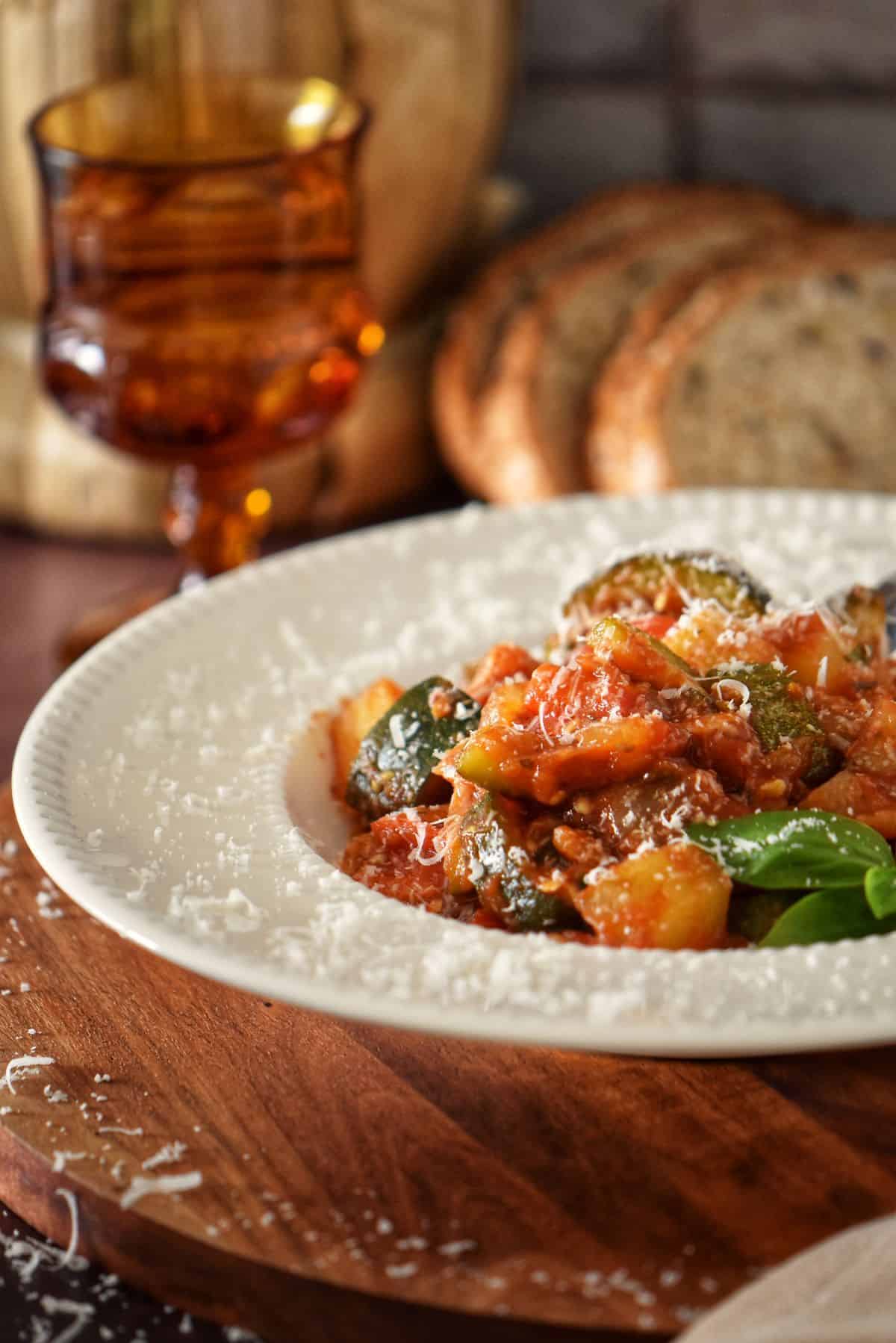
WANT TO SAVE THIS RECIPE?
If you appreciate a dish that relies on instinct and ingredients rather than strict measurements and procedures, then this Ciambotta recipe is perfect.
This delightful blend of fresh summer vegetables is sautéed in two pots to bring out the flavors. The beauty of this dish lies in its flexibility – you can make it your own.
Although the ingredients may vary from one Italian region to another, the classic vegetables such as eggplant, peppers, zucchini, potatoes, and tomatoes remain constant.
Ciambotta is the friendly neighbor of the cooking world – it invites you to improvise and adapt to your taste.
Whether you prefer a hearty, rustic stew or a lighter, vegetable-forward medley, Ciambotta can be your canvas.
Today, I’m sharing a version of the family recipe I grew up with that is more than just a recipe; it’s an invitation to savor the flavors of summer, one spoonful at a time.
Jump to:
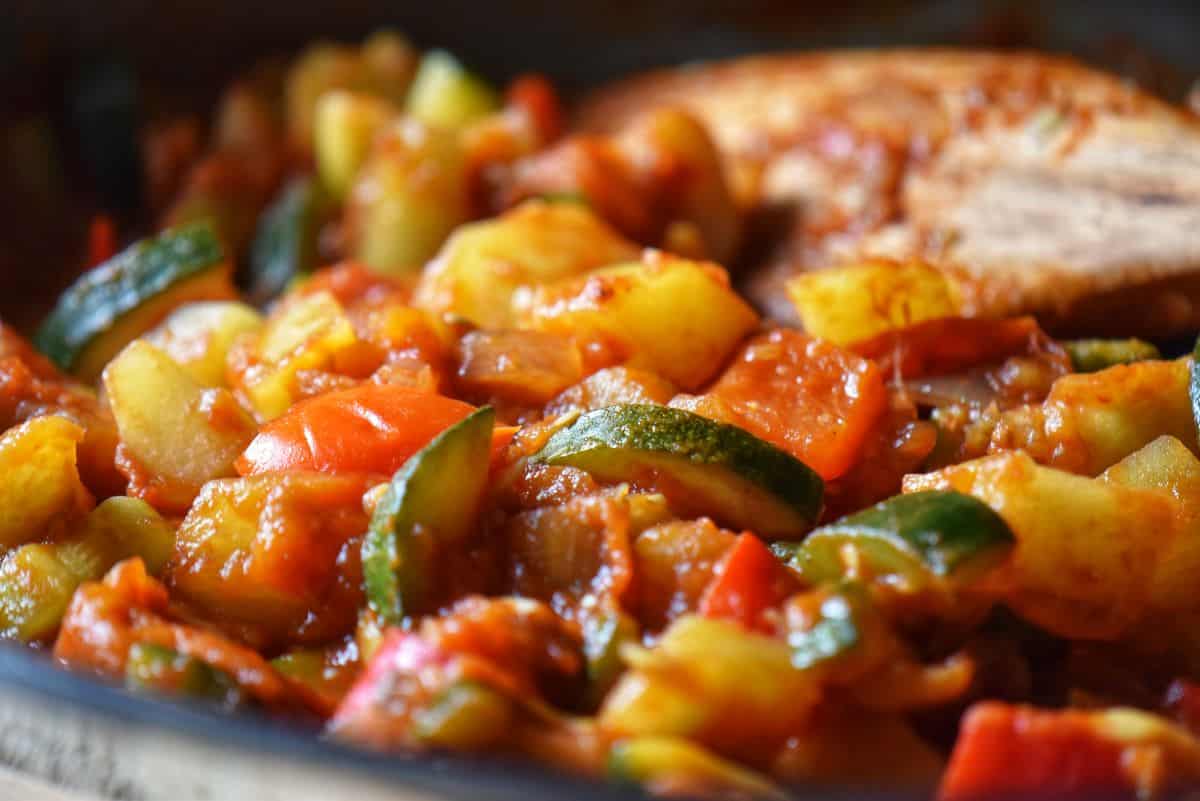
What is Ciambotta?
Ciambotta, also known as giambotta or cianfotta is a vegetable stew that has its roots in Southern Italy. It’s a flavorful dish with various summer vegetables such as eggplant, zucchini, bell peppers, potatoes, onions, tomatoes, garlic, fresh herbs, and olive oil.
This traditional Southern Italian vegetable dish, using seasonal produce, is easy to make, highly affordable, and cost-effective.
Many people draw comparisons between ciambotta and the well-known French ratatouille.

Ingredient notes
To create this hearty dish, you’ll need a medley of fresh, seasonal vegetables, olive oil, garlic, and an assortment of herbs.
Fresh Seasonal Vegetables
At the heart of Ciambotta is a combination of vegetables. Traditionally, this dish celebrates what’s ripe and ready in the garden or market. Plum tomatoes, bell peppers, eggplants, and zucchini (I used cucuzza as pictured above) are the stars of the show, but feel free to experiment with other seasonal favorites, like green beans and peas.
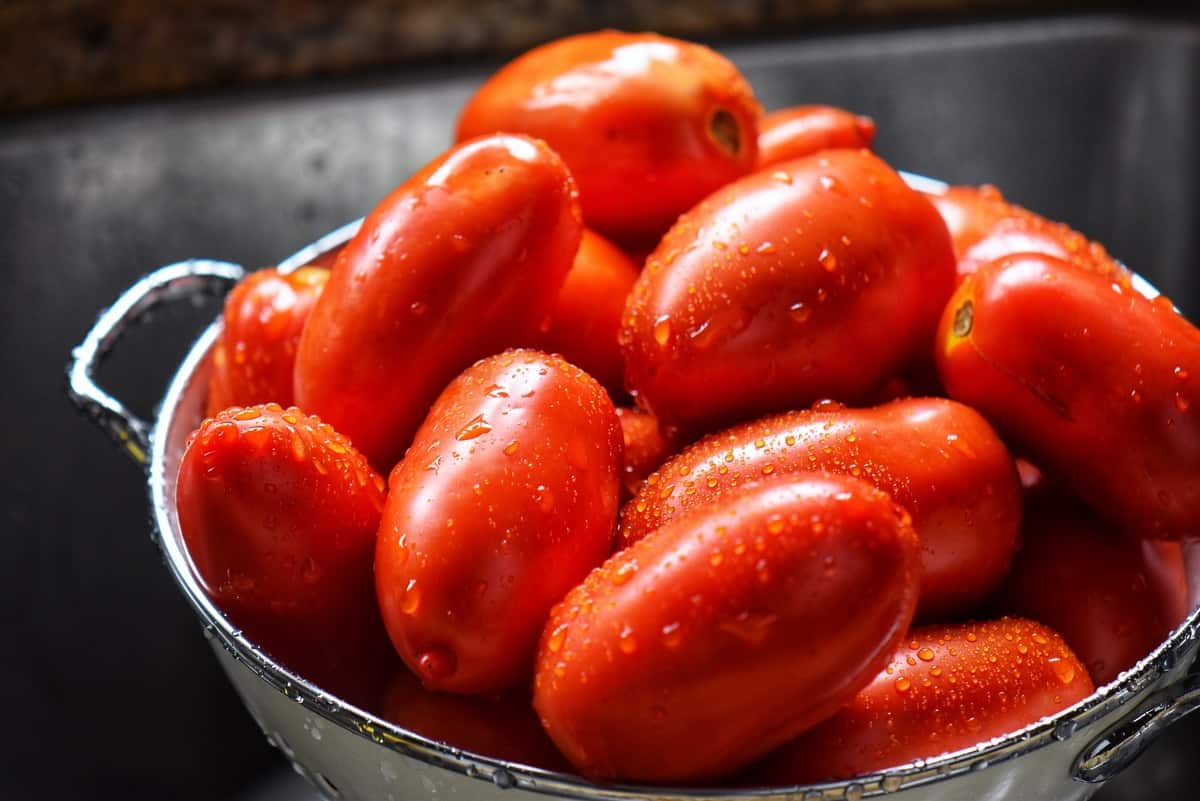
When it comes to tomatoes, you have some flexibility in choosing between fresh, canned, or passata (tomato purée).
Fresh Tomatoes: Using ripe, fresh, in-season tomatoes straight from the garden or market is the traditional and preferred choice. They provide a burst of bright, natural flavor and a pleasing texture to your Ciambotta. Read more: How to Store Tomatoes
Canned Tomatoes: Canned tomatoes can be a convenient choice, especially when fresh ones are out of season or unavailable. Look for canned whole or diced tomatoes without additives. Crushed tomatoes can also work well if you prefer a slightly smoother texture. Remember to adjust the cooking time to allow the flavors to meld together. Read more: Canning Tomatoes
Passata: Passata, which is essentially tomato purée, offers a smooth and velvety consistency to your Ciambotta. It’s a shortcut that’s particularly handy when you want a quicker dish version without compromising flavor. Passata usually contains strained, cooked tomatoes and can be a great time-saver.
Tomato Paste: A few tablespoons of tomato paste can be added to deepen the tomato flavor of your vegetable stew. This is optional.
Feel free to choose the tomato option that suits your preference and availability. Regardless of your choice, Ciambotta’s flavors will shine through as long as you use quality ingredients and cook them with care.
In the following sections, I’ll guide you through the steps to make a mouthwatering Ciambotta, regardless of the tomatoes you choose.

Potatoes: Choosing the Right Variety
Potatoes offer a comforting and hearty element to this Italian peasant dish, whether peeled or unpeeled. When selecting the best potato variety for your stew, consider these options:
Yukon Gold: Yukon Gold potatoes are popular for Ciambotta due to their creamy texture and buttery flavor. They also hold their shape well during cooking. If you prefer a slightly firmer potato in your stew, this is the potato for you.
Russet: Russet potatoes are known for their fluffy texture when cooked, but they can also be used in Ciambotta if you enjoy a more tender potato that breaks down slightly during simmering, contributing to a thicker sauce.
Red Potatoes: Red potatoes are another good choice. They have thin skins and a waxy texture that holds up in the stew, providing a nice contrast to the other ingredients.
Fingerling Potatoes: If you prefer smaller, fingerling-style potatoes, they can be used whole or halved. They offer a unique visual appeal and tend to cook evenly.
Olive Oil
Olive oil, often called “liquid gold”, is the foundation of many Italian dishes, and ciambotta is no exception. If you can, use a high-quality olive oil that enhances the flavors of the vegetables as they cook.
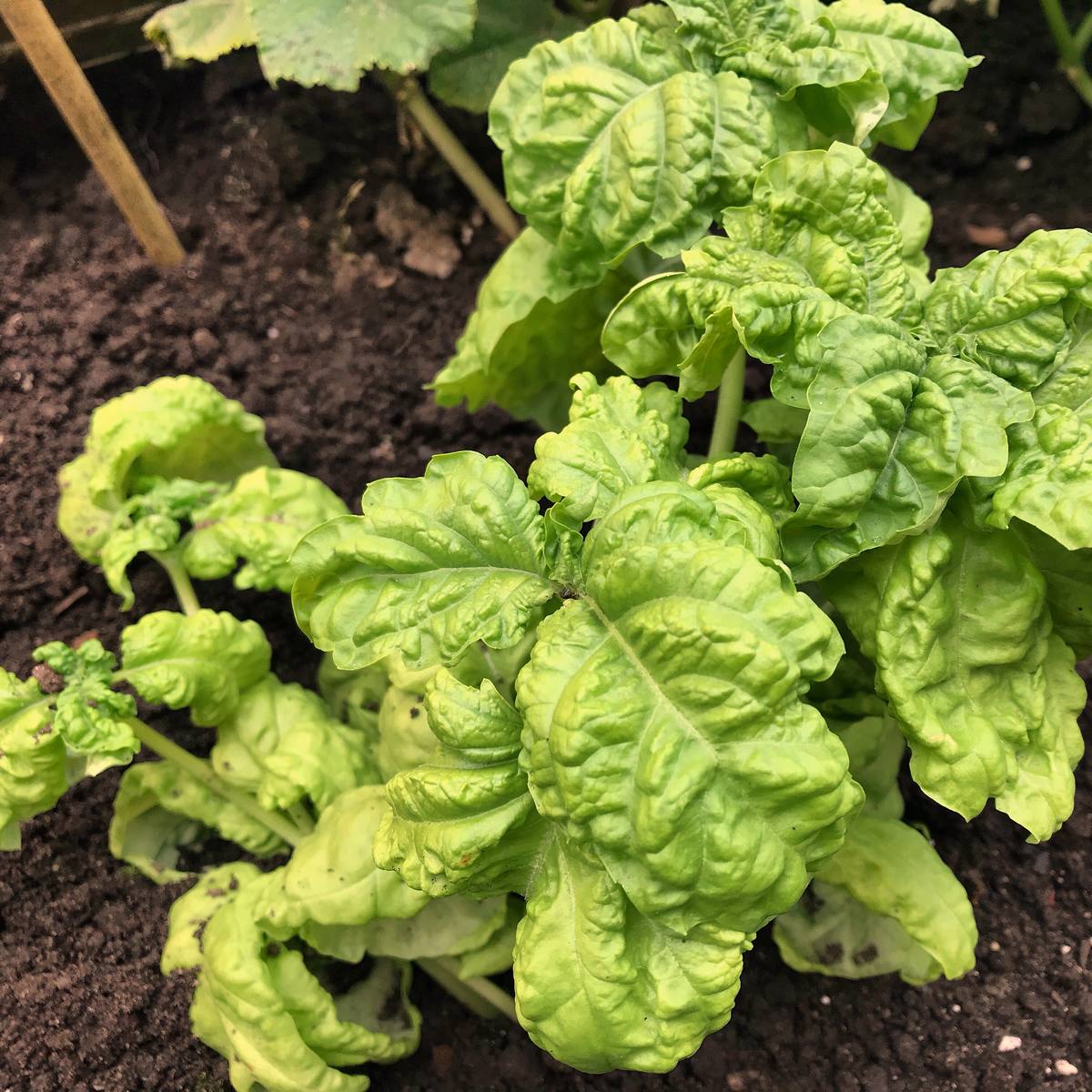
Garlic and Herbs
Combining garlic and Italian herbs like basil, flat-leaf parsley and oregano brings a burst of aromatic goodness to your Ciambotta. Fresh is always better, especially if they grow in your backyard.
Let’s prep our Ciambotta recipe
Before we can sauté and combine the ingredients, we must chop them.
Start by washing all the vegetables and herbs thoroughly. More specifically, you need:
- Zucchini or yellow squash, 3 medium
- Italian eggplants, 3-4 medium
- Red bell peppers, 2 large or equivalent
- Potatoes, 3 medium
- Roma tomatoes, 5-6 medium
- Onion, 1 medium (no need to wash)
- Garlic cloves, thinly sliced (no need to wash)
- Fresh basil (adjust to taste), 2 tablespoons minced
- Italian parsley (adjust to taste), 2 tablespoons minced
- Fresh oregano (adjust to taste), 1 tablespoon minced
Note: The quantities mentioned here are approximate and can be adjusted to suit your taste and what you have available.
To prepare the zucchini, cut them into quarters, ensuring they’re approximately the same size. Peel and dice the onion and eggplants into half-inch pieces and chop the red bell peppers into bite-sized chunks. Thinly slice the garlic cloves. Keep these vegetables aside on the cutting board.
You’ll also need to peel and dice 3 potatoes into bite-sized pieces. To prevent them from discoloring, soak them in a bowl of water.
When it comes to tomatoes, I like to remove the skins. Here is an easy tomato peeling hack. Score the bottoms, place them in a bowl and pour boiling water over them. After waiting for a few minutes, the skin will easily peel off. Chop them up into pieces. Set them aside in a separate bowl.
Lastly, pat dry the herbs. Finely chop/mince them. Set them aside for now.
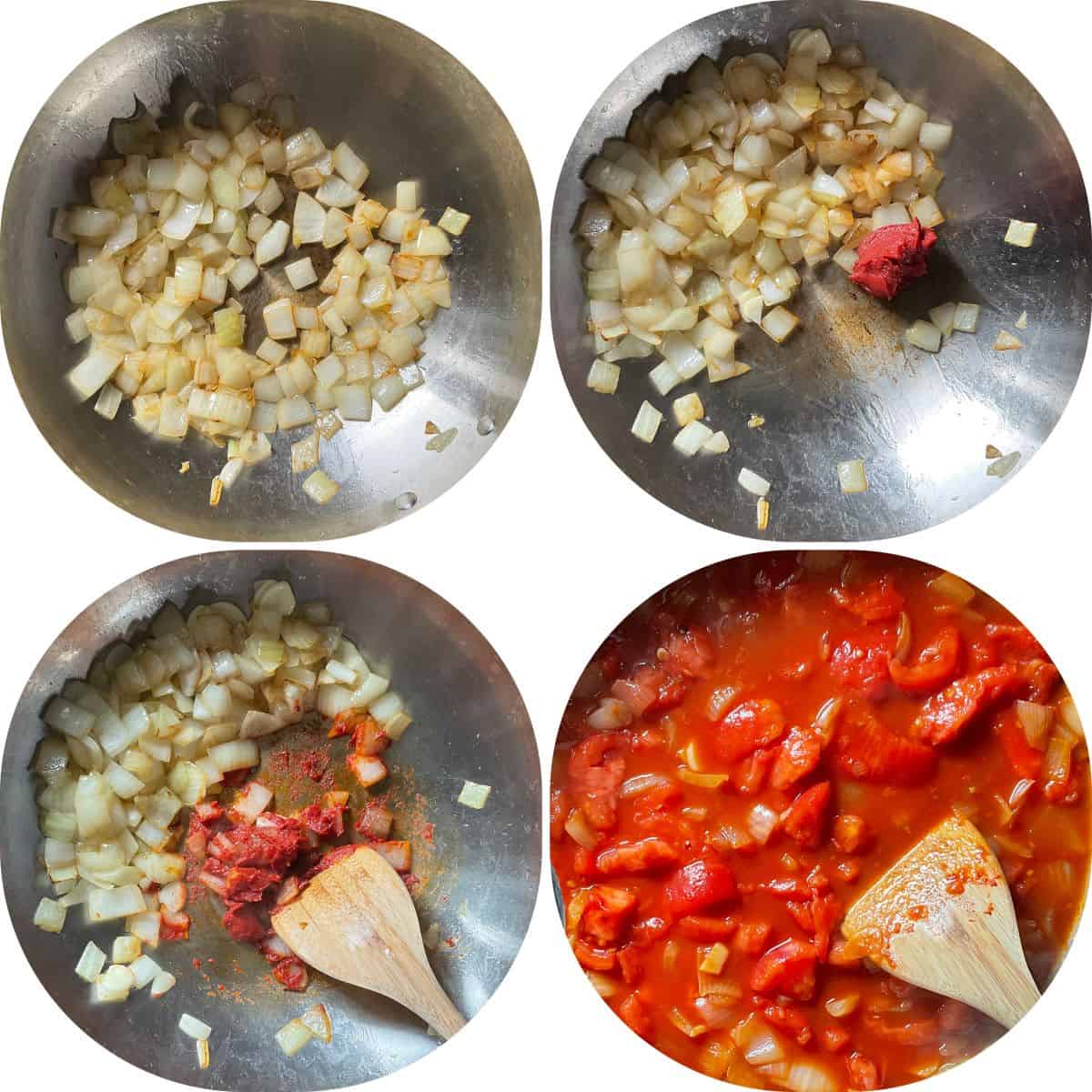
Step-by-step instructions
To maximize flavors and cook the Ciambotta efficiently, we will use two separate pots or Dutch ovens.
In the first large pot, heat 2 tablespoons of olive oil over medium heat until it shimmers.
Once the oil is hot, add the chopped onions and sauté them until they turn translucent and fragrant. This usually takes around 3 to 4 minutes. Stir in the tomato paste and sliced garlic cloves, cooking for 1-2 minutes to release their flavors. If you enjoy a little heat, you can add a few pinches of chili flakes at this point. You can also add a hot chili pepper.
In the same pot with sautéed onions, add the peeled Roma tomatoes, 1 cup of passata, and 1 cup of water. Bring to a gentle simmer. Season with salt and pepper to taste.
In the second Dutch oven, heat 2 tablespoons of olive oil over medium heat.
Add the chopped red peppers, zucchini, diced eggplant, and potatoes and cook, stirring occasionally, until they soften slightly, 7-10 minutes.
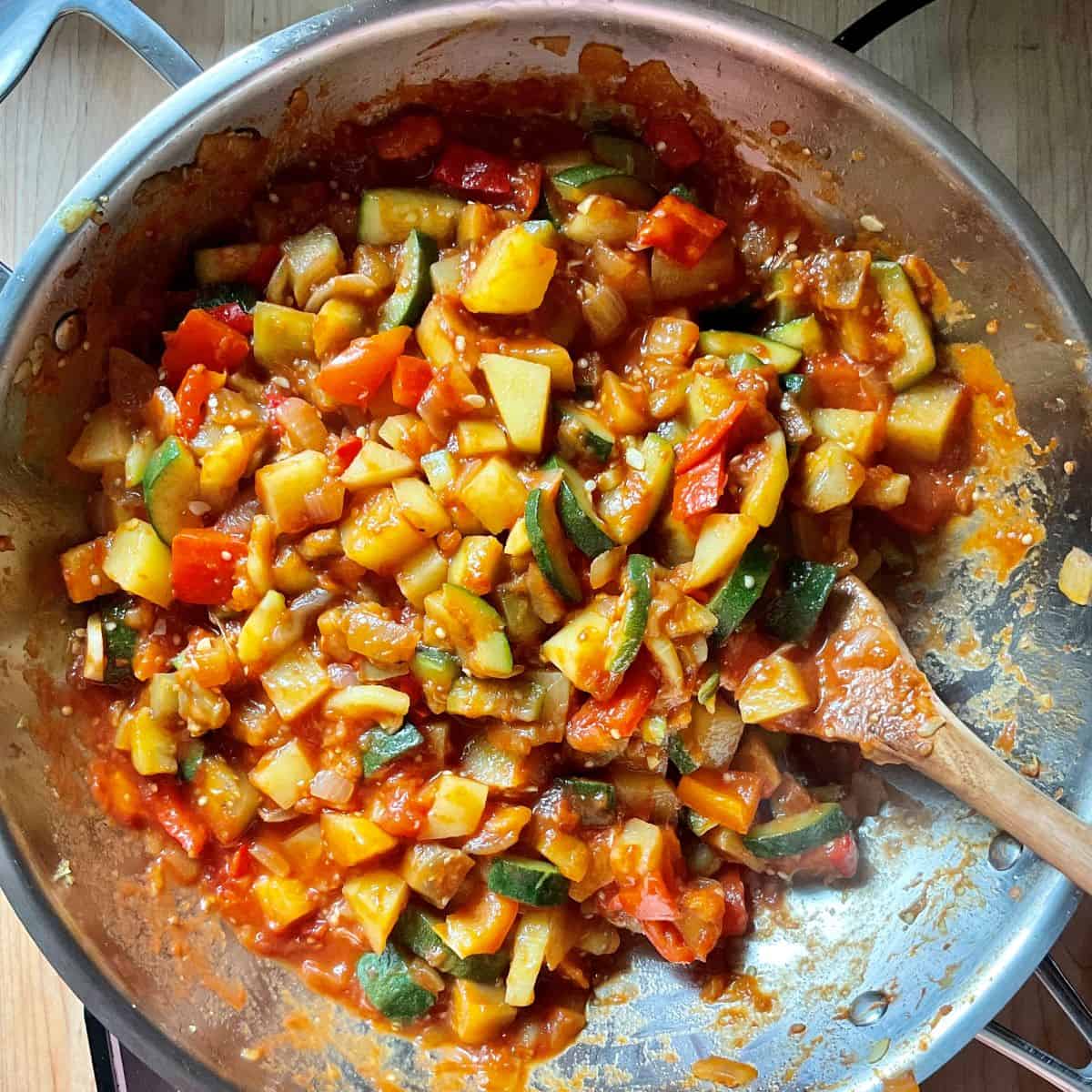
Transfer the sautéed zucchini, eggplant, potatoes, and peppers from the second pot into the first pot with the tomato mixture.
Ensure all the ingredients are well combined.
Slightly cover the pot and allow the vegetables to simmer for approximately 20-30 minutes, or until all the vegetables, including the potatoes, are tender and infused with delicious flavors.
If necessary, add a little water to prevent the stew from drying up and burning.
Add the chopped fresh herbs, taste and adjust for salt and pepper.
Recipe variations
Ciambotta is a versatile dish that can be adapted to suit different tastes and dietary preferences. Here are some exciting variations to consider:
Adding protein: For a heartier meal, add protein sources like Italian sausage, chicken, shrimp or other seafood.
Vegetarian ciambotta is a great option for those looking for a meatless meal. Chickpeas, lentils or white beans are often added to the dish for protein and texture. You can also experiment with plant-based sausage or tofu as protein alternatives.
Spicy variation: If you enjoy a bit of heat in your dishes, you can create a spicy variation by incorporating chili flakes or different kinds of spicy peppers like jalapeños or red chili peppers.
Basil pesto variation: Consider adding fresh basil pesto at the end of the cooking process like we did for this zucchini pasta recipe. Turn off the heat, and remove it from the stove. Spoon in 2-3 tablespoons (or to taste) of your favorite basil pesto.

Serving suggestions
Feel free to explore these serving options and variations to create a Ciambotta experience that suits your style and preferences. Whether enjoyed alone or paired with your favorite foods, ciambotta is a great end-of-summer vegetable dish.
- Serve with pasta: Transform this late summer vegetable dish into a pasta recipe with veggies.
- Polenta topping: Spoon the ciambotta over the polenta and top with grated Parmesan or Pecorino cheese. This creamy polenta recipe pairs perfectly with the hearty stew.
- As a side dish: Serve ciambotta as a side dish to chicken spiedini, garlic shrimp or baked cod fish.
- Pair with crusty bread: Use Italian crusty bread or this Italian focaccia recipe to mop up the flavorful juices of the stew.
Alternatively, savor the rich flavors of Ciambotta on its own as a standalone dish—simple garnish with a generous sprinkle of grated Italian cheese, such as Parmesan or Pecorino Romano, a drizzle of olive oil and enjoy!
Tips
- Use fresh, seasonal vegetables. Using locally grown fresh produce is essential to capture the authentic flavors of Ciambotta.
- Cut your vegetables into uniform pieces to ensure even cooking and a consistent texture in your stew. Aim for bite-sized pieces of roughly the same size.
- If you prefer, use unpeeled eggplant and potatoes.
- If using large zucchini, you may want to deseed them.
- Allow the vegetables to simmer gently over low to medium heat. This slow cooking process makes them tender without losing shape. Stir occasionally to ensure even cooking and to prevent sticking.
- Add the fresh herbs towards the end of the cooking process to preserve their flavor and aroma.
- Feel free to experiment with different spices and herbs. While it traditionally features garlic, and basil, don’t hesitate to try additions like cumin, or paprika to create a unique flavor profile.
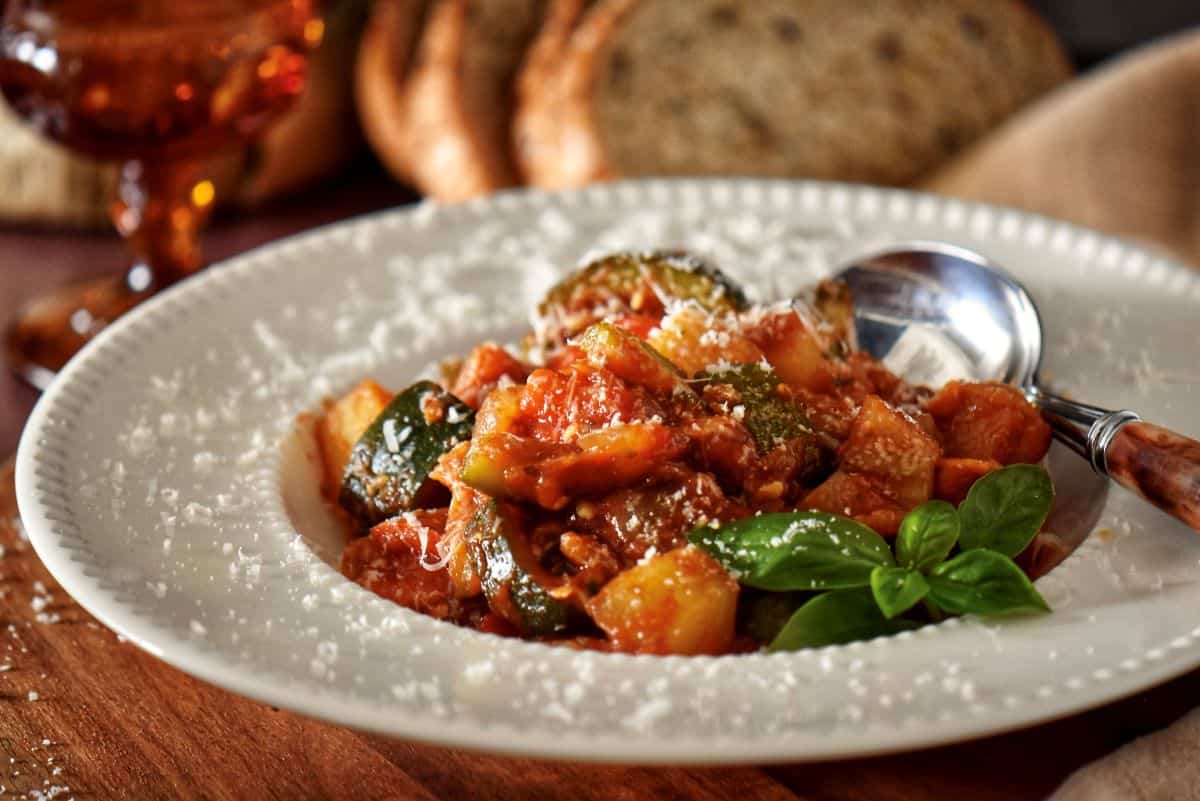
How to store
Refrigeration: If you have leftovers, store them in the refrigerator to enjoy within the next 3 days. Use an airtight container and ensure the stew cools to room temperature before refrigerating. When reheating, heat it on medium heat until piping hot for the best taste.
Freezing: Allow the stew to cool to room temperature, then transfer it to an airtight container or freezer-safe plastic bag. Label the date and contents, and place it in the freezer; Ciambotta can be safely frozen for up to three months.
FAQ
Yes, you can prepare Ciambotta in advance. In fact, it tastes better when reheated. Use within three days of it being refrigerated. Great for meal prep!
Ratatouille originates from the Provence region of France, while Ciambotta is a classic Italian vegetable stew. While they share some ingredients like eggplant and bell peppers, they are distinct dishes with unique flavors and regional origins.
Italian summer vegetable dishes
Italian cuisine celebrates the bounty of summer with a variety of delicious vegetable-based dishes. Here are a few examples:
- Insalata Caprese: A simple yet elegant salad that combines fresh tomatoes, mozzarella cheese, basil leaves, and a drizzle of olive oil. It’s a classic way to showcase the flavors of ripe summer tomatoes.
- Peperonata: This dish features sautéed bell peppers, onions, and garlic, all simmered to a sweet and savory perfection. It’s a colorful and flavorful summer side dish.
- Green Beans and Tomatoes: This popular dish combines fresh garlicky green beans and fresh tomatoes seasoned with garlic, basil, and olive oil. It’s a vibrant and flavorful summer side.
- Pipi e patate: This dish originates from Calabria and is a simple Italian recipe featuring peppers and potatoes. Indulge in the delightful combination of slightly charred peppers and crispy, creamy potatoes in this flavorful side dish that pairs perfectly with any main course.
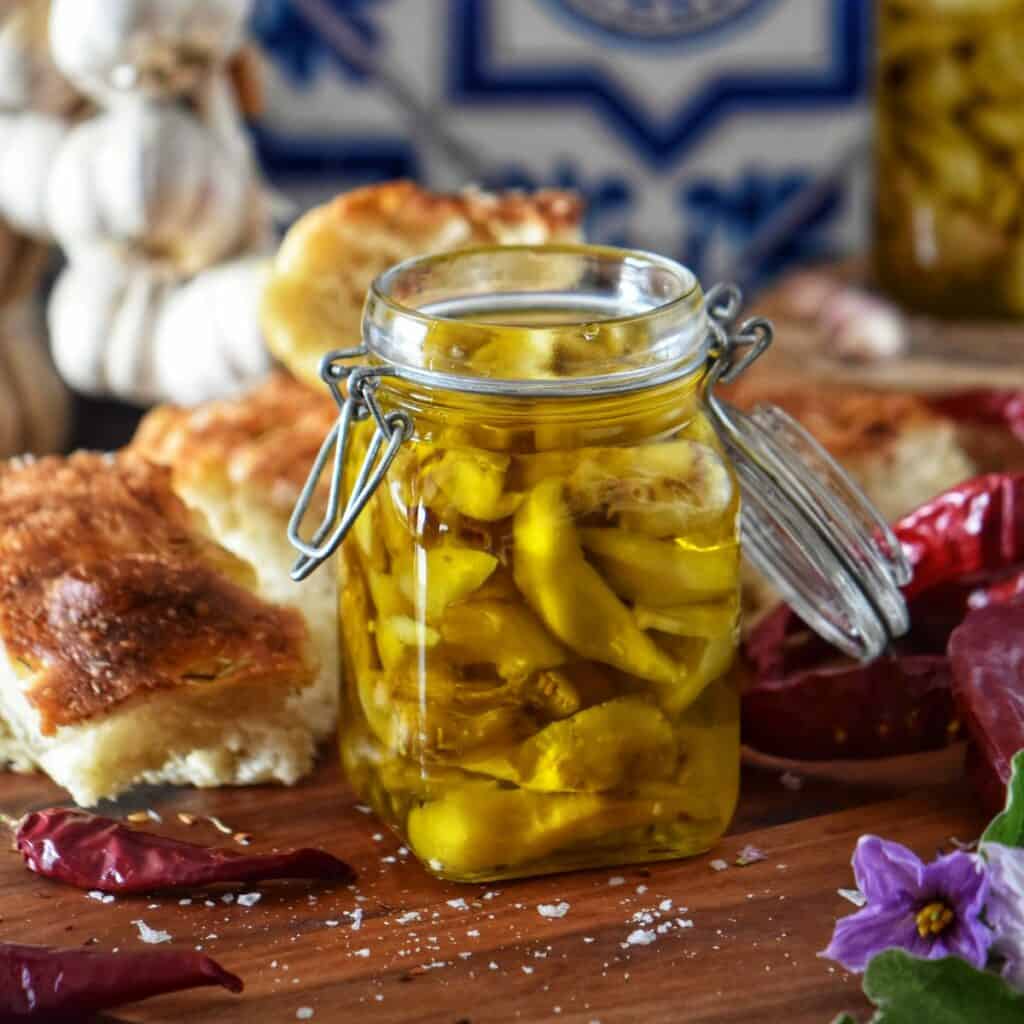
Pickled Eggplant
Thin slices of eggplant marinated in a tangy vinegar and garlic mixture. This pickled eggplant recipe is a great way to preserve summer flavors for a little longer.
Recipe origins
Growing up Italian, Ciambotta was more than just a recipe; it was a delicious tradition that marked the end of summer.
My parents, particularly my father, had a deep pride in nurturing our backyard garden. His meticulous rows of staked tomato plants, flourishing potted Italian eggplant, and abundant zucchini and summer squash were a testament to his green thumb.
I fondly remember a Sicilian neighbor who planted Cucuzza along the fence bordering my dad’s property. He was an exceptionally generous neighbor, always sharing his harvest, just like my dad.
My mom, a master of Italian culinary traditions, created the most delectable Ciambotta using Cucuzza and passata from our annual “sauce-making” ritual.
As I pen down this article, I can’t help but think that I’ve only harvested one cucuzza from my backyard this year. This simple fact brought back memories of my dad’s neighbor and the Ciambotta my mom would make with it.
Both my parents were born in different regions of Southern Italy, so there was a special connection to this “cucina povera” meal of ciambotta Napoletana.
Like most recipes, I’ve tinkered with it over the years, learning through trial and error and adjusting based on my family’s feedback.
I hope you get a chance to try this version of Ciambotta, which carries the flavors of tradition and the echoes of my family’s love for homegrown ingredients, especially tomatoes!
THANKS SO MUCH for following and being part of the She Loves Biscotti community, where you will find Simple & Tasty Family-Friendly Recipes with an Italian Twist.
Ciao for now,
Maria
★★★★★ If you have made this Italian ratatouille, I would love to hear about it in the comments below and be sure to rate the recipe!
Recipe
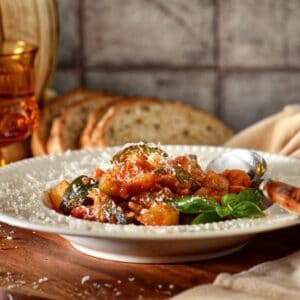
Easy Ciambotta Recipe: Italian Vegetable Stew
WANT TO SAVE THIS RECIPE?
Ingredients
- 4 tablespoons olive oil extra virgin, separated
- 1 medium onion diced
- 2 cloves garlic sliced
- 2 tablespoons tomato paste
- pinch chili flakes optional
- 5-6 plum tomatoes peeled and chopped
- 1 cup passata
- 1 cup water
- 3 medium zucchini cubed
- 3-4 cups eggplant peeled and cubed
- 3 medium potatoes peeled and cubed
- 2 large sweet peppers stemmed, seeded and cubed
- 2 tablespoons parsley chopped
- 2 tablespoons basil fresh, chopped
- 1 tablespoon oregano fresh
- salt and pepper to taste
- grated cheese optional, to garnish
- olive oil optional, to garnish
Instructions
- Heat 2 tablespoons of extra virgin olive oil in a large soup pot or Dutch oven over medium heat.
- Add the chopped onions and sauté them until they turn translucent and fragrant. This usually takes around 3 to 4 minutes.
- Stir in the tomato paste and sliced garlic cloves, cooking for 1-2 minutes to release their flavors. If you enjoy a little heat, add a pinch of chili flakes.
- Add the peeled Roma tomatoes, 1 cup of passata, and 1 cup of water. Bring to a gentle simmer. Season with salt and pepper to taste.
- In the second pot, heat 2 tablespoons of olive oil over medium heat.
- Add the quartered zucchini, diced eggplant, potatoes and peppers. Cook, stirring occasionally, until they soften slightly, 7-10 minutes.
- Transfer the sautéed vegetables into the first pot with the tomato mixture.
- Ensure all the ingredients are well combined.
- Slightly cover the pot and allow the vegetables to simmer for approximately 20-30 minutes, or until all the vegetables, including the potatoes, are tender and infused with delicious flavors. If necessary, add a little water to prevent the stew from drying up and burning.
- Add the chopped fresh herbs, taste and adjust for salt and pepper.
- Ladle the stew into bowls. Garnish with grated cheese and a drizzle of olive oil (optional).
Video
Notes
- Use fresh, seasonal vegetables. Using locally grown fresh produce is essential to capture the authentic flavors of Ciambotta.
- Cut your vegetables into uniform pieces to ensure even cooking and a consistent texture in your stew. Aim for bite-sized pieces of roughly the same size.
- If you prefer, use unpeeled eggplant and potatoes.
- If using large zucchini, you may want to deseed them.
- Allow the vegetables to simmer gently over low to medium heat. This slow cooking process makes them tender without losing shape. Stir occasionally to ensure even cooking and to prevent sticking.
- Add the fresh herbs towards the end of the cooking process to preserve their flavor and aroma.
- Feel free to experiment with different spices and herbs. While it traditionally features garlic, and basil, don’t hesitate to try additions like cumin, or paprika to create a unique flavor profile.


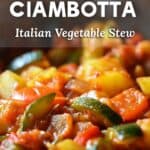
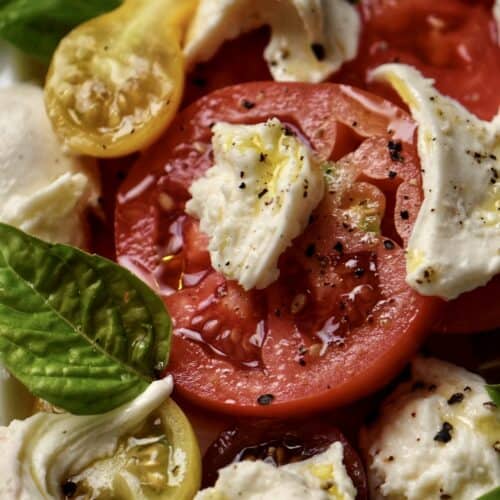
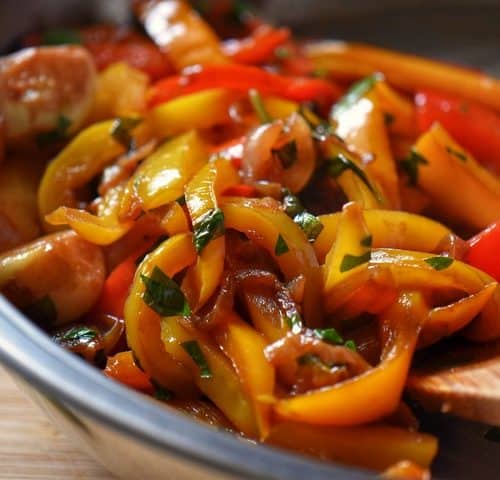
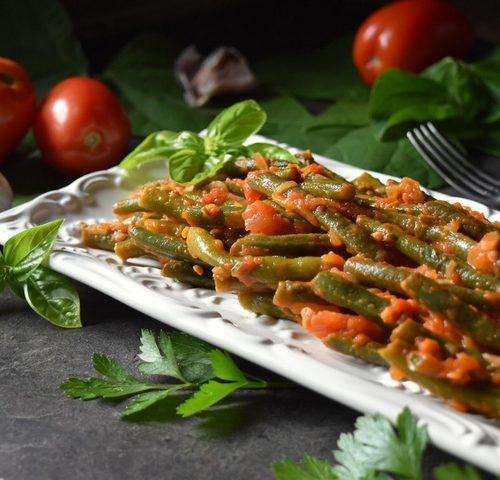
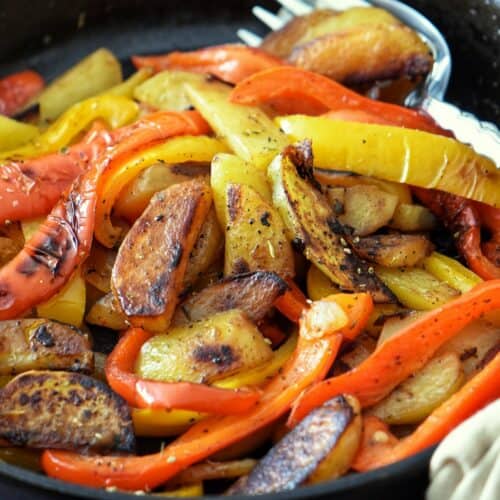
Angela
My family makes ciambotella, as we call it, and my mom adds sausage as well as a beaten egg. It is a very hearty and delicious meal!
Tina
Maria, when I saw this recipe I knew I had to try it for my 97 year old Dad who came to the US from Sicily. This recipe was easy to put together. I had just made a pot of stock. So used the stock instead of water with the passata. Wow, the flavors were beautiful. I added some grated cheese and good olive oil into the final product before I packaged it to take to him. Your recipes never disappoint. Thank you!
Maria
God bless your dad!
I am so thrilled to read this! Thanks so much for sharing Tina.